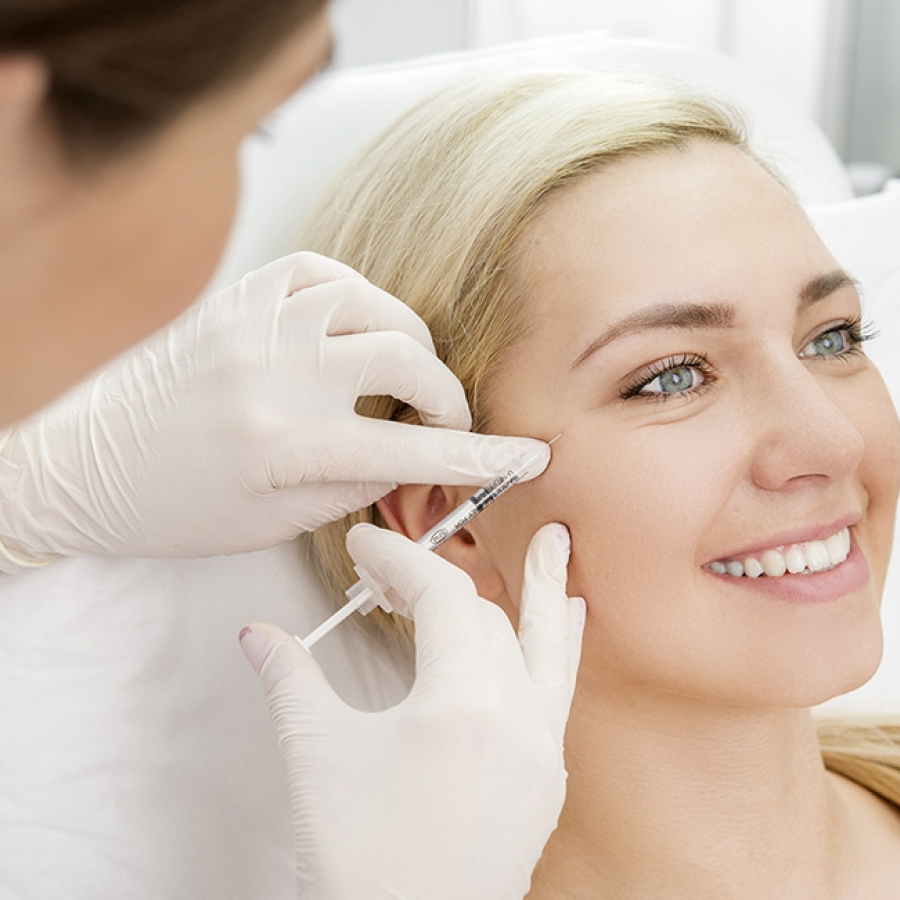
Clinical
Why NPs Are Safe, Trusted Med Spa Professionals
By Eric Atienza, Assistant Director of Digital Marketing and Marketing Technology, and Madilyn Moeller, Marketing Content CoordinatorWith the growing popularity ...
Posted By Madilyn Moeller, Tuesday, September 24, 2024
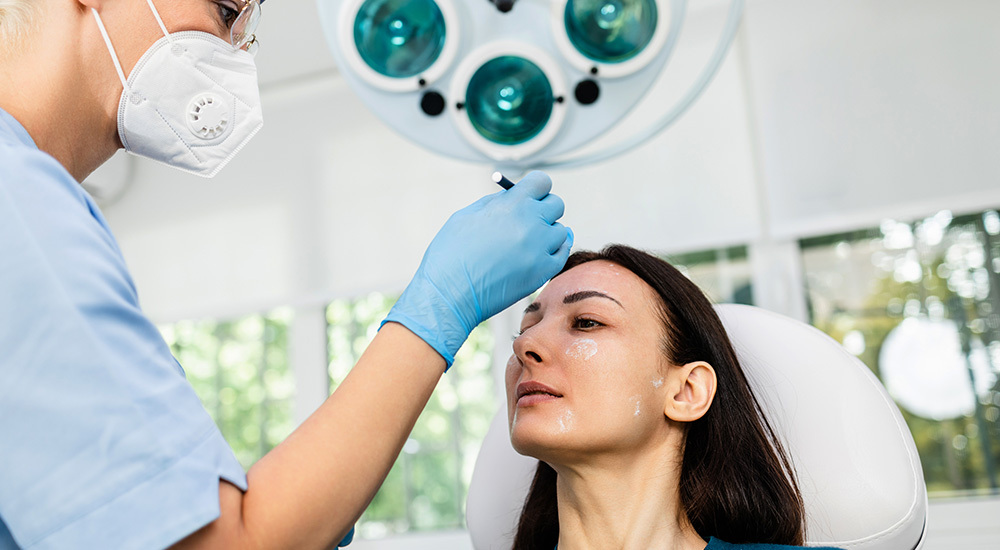
By Madilyn Moeller, Marketing Content Coordinator, American Med Spa Association (AmSpa)
Med spas are medical practices, and that informs how they operate, who holds the needle, and what protections they have in place for aesthetic patients. Whether you’re curious about the latest medical aesthetic treatments or are a long-time med spa patient, understanding the health care at the heart of aesthetics will help you make more informed choices about your care. Here is what you should know as a patient, with insight from a sought-after aesthetic practitioner and trainer and from the health care attorneys who help med spas comply with medical aesthetic regulations to bring you the non-invasive cosmetic procedures you know and love.
Meredith Harris, MS, WHNP, New Life Aesthetics
Meredith Harris, women’s health nurse practitioner (WHNP), is the owner and founder of New Life Aesthetics in Raleigh, North Carolina. After spending 10 years focused on women's health, she found the blend of her artistic gifts and her passion of serving women in the field of medical aesthetics. Harris is a highly sought-after educator and trainer in the medical aesthetics market. When she is not seeing guests in the office, she can be found hosting injectors for training, traveling to medical practices throughout the country to educate and consult, speaking from the main stage of live medical conferences, and serving on advisory boards for Allergan Aesthetics. Detailed care, in-depth knowledge of facial anatomy, and a passion for education and safety in medical aesthetics is notable through every touchpoint of Harris's work.
Vanessa Lee, RN, The Things We Do
Vanessa Lee, RN, is the force behind The Things We Do and a world-renowned medical aesthetic provider. She is highly sought after for her dedication to natural intention beauty guidance and her commitment to inclusivity and ethical practice while providing natural yet transformative results. A true creative at heart, Lee infuses her beauty and skin care methodologies with the aim of accentuating natural beauty and facial harmony. Fueled by her passion for intentional beauty and her deep commitment to inclusivity, Lee formulated her own celebrity-loved skin care line that highlights effective ingredients for all skin tones. Her reach continues to expand, with five locations in California and Hawai’i.
ByrdAdatto
ByrdAdatto is a national business and health care law firm that serves clients in many industries, including the highly regulated aesthetics industry. ByrdAdatto combines deep industry knowledge with complex regulatory experience. The firm’s attorneys have become a national voice, routinely lecturing throughout the country at aesthetics, medical, and legal conferences. Inspired by the reach of training and education provided at conferences, ByrdAdatto launched the Legal 123s with ByrdAdatto podcast to help simplify complicated issues that come with owning a successful business. ByrdAdatto eliminates inefficiencies often associated with law firms and, instead, offers creative solutions while striving to make the law accessible and easy to understand.
ByrdAdatto is the Dallas-based law firm that powers the legal resources provided by American Med Spa Association (AmSpa). Alex R. Thiersch, JD, founder and CEO of AmSpa, is also a partner of ByrdAdatto.
A medical spa blends elements of both an aesthetic medical center and a day spa, featuring four key components: (1) offering non-invasive, non-surgical aesthetic medical treatments; (2) operating under the oversight of a licensed physician or independent practitioner; (3) having services delivered by skilled and certified practitioners; and (4) ensuring appropriate supervision by a qualified healthcare professional.
The design of a medical spa often gives the first clue of this hybrid. When you walk in, you might see a retail area with medical-grade skin care products and a friendly receptionist who hands you paperwork to fill out in a plush reception lounge. When you are brought back for treatment, however, everything is clinical. Treatment rooms may have an elevated look, but the clinical elements are the same as you would expect in a typical health care outpatient setting, from the treatment chair to the sink, sanitizers, equipment and overhead lighting.
Medical spas are establishments dedicated to non-invasive aesthetic medical services. These range from stand-alone clinics that specialize in laser hair removal, IV therapy or injectables, all the way to full-service med spas that offer an array of services.
You can get a facial at a spa or medical spa. The advanced treatments, personnel and oversight are where they start to differ.
Med spas cater to different needs than traditional spas; they are essentially medical practices that offer advanced skin and aesthetic treatments. Traditional day spas are focused on relaxation and wellness, offering services such as massages and facials, whereas medical spas offer medically supervised procedures including neuromodulators and laser treatments. Your massage therapist or facialist likely has specialized training in their areas of expertise, but providers at a med spa require licensed medical supervision and a health care license of their own, depending on the treatment being performed.
Day spas operate as retail enterprises more akin to hair salons, while medical spas are considered medical practices. That does not mean that med spas can’t participate in retail. According to the 2024 Medical Spa State of the Industry Report, 86% of medical spas offer retail skin care products. Day spas are also more similar to salons when it comes to tipping or when advertising and promoting the business.
Also, there are fewer restrictions to own a day spa compared to a medical spa. The owner of a day spa does not have to be a licensed aesthetician—only the staff who perform treatments are required to be licensed and trained. In contrast, many states require med spa owners to be a licensed physician or for a physician to have majority ownership with other health care personnel.
Each of these differences reflects the nature of their business. One is focused superficially, from the outer layer of the skin only; the other specializes in non-invasive or minimally invasive cosmetic treatments, which comes with heightened regulation. They share a common goal of enhancing the appearance and well-being of the clients in their care.
A medical spa is a medical facility that operates under the full-time supervision of a licensed health care professional. At a medical spa, you can enjoy many of the same treatments that you might get at a spa, but with access to advanced technology and techniques that day spas do not routinely offer. Medical spa staff have been licensed, educated and trained to safely perform medical procedures and aesthetic treatments.
Med spas can vary in their treatment offerings, but all of them perform services that qualify as medical treatments.
Full service medical spas offer a wide range of aesthetic medical services, such as neuromodulators (botox) and dermal fillers, laser energy devices and body contouring, thread lifts, IV therapy, microneedling, medical weight loss and more. Some of the lighter treatments include personalized facials, chemical peels and dermaplaning. These seemingly-less-invasive treatments can still be considered medical treatments if they impact or affect any living tissue of the body, including anything under the top layer of the skin, or the dead skin cells of the epidermis.
As our legal partners described in this previous article, most states consider it to be the practice of medicine when a person diagnoses, treats, operates or prescribes for any human disease, pain, injury, deformity or other physical or mental condition of another person. Med spa treatments, then, are medical services.
Medical treatments have specific requirements. In most states, patients must have an initial face-to-face consultation with a doctor, nurse practitioner or physician assistant. The treatment must be performed by or delegated to an individual acting within the appropriate scope of practice.
As a patient, this means you should expect to see a prescribing provider (a physician, nurse practitioner or physician assistant) in an initial consultation, where they will decide what treatment you are a good candidate for and prescribe the course of medical treatment. They can then perform the treatment or delegate it to an adequately trained person whose license allows them to perform that treatment.
Whether or not a medical assistant, aesthetician, licensed vocational nurse (LVN) or licensed practical nurse (LPN), registered nurse (RN), physician assistant or nurse practitioner can perform a specific treatment is decided by their licensing board. These rules are laid out as the provider’s “scope of practice.” For example, Connecticut regulations as of September 2024 allow only physicians, physician assistants, nurse practitioners and RNs to inject dermal fillers. Dermal fillers are currently beyond the scope of practice for LVNs, aestheticians and medical assistants/laser technicians in Connecticut.
AmSpa Plus Members who are curious about who can do what in their state can log in to explore a treatment delegation table for their state, available as part of their med spa legal summaries.
If you are questioning whether a service qualifies as a medical treatment, it’s better for the med spa to err on the side of caution and act as though performing that treatment is the practice of medicine. When in doubt, do your research to find out who your state says should be performing your cosmetic treatment.
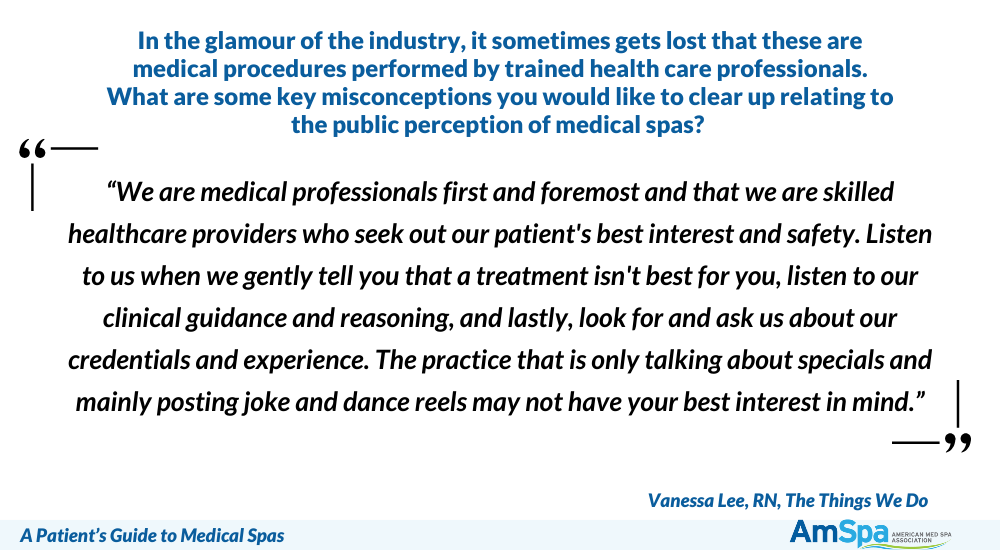
Aesthetic practitioners are licensed health care professionals. Even in the case of an unlicensed person acting as a medical assistant in those specific states for certain treatments, they still act under the direction of a highly trained, licensed medical professional.
At a med spa you will encounter several license types: medical doctor (MD), osteopathic doctor (DO), nurse practitioner (ARNP, APRN, NP; DNP denotes Doctor of Nursing Practice, a terminal nursing degree), physician assistant (PA), registered nurse (RN), licensed practical or vocational nurse (LVN or LPN), licensed aesthetician/esthetician (LE). You may also come across certified laser technicians (CLT), which we will discuss later.
How do you know what license your med spa practitioner holds? First look at the med spa website, then check the embroidery on their scrubs for their name and credentials. Providers often include academic titles in their bios, so for example, their scrubs might list titles like MSN, APRN-BC, CANS. These initials state that this person has completed their masters of science in nursing degree, is a board certified advanced practice registered nurse in their state, and is a certified aesthetic nurse specialist, as administered by the Plastic Surgical Nursing Certification Board.
AmSpa’s treatment delegation tables include medical assistants for a reason. In some states, physicians can delegate certain treatments to unlicensed medical assistants. They operate as an assistant or extension of the licensed provider. When the on-site doctor decides to delegate to an unlicensed medical assistant, they take on the responsibility and accountability to determine if that person is able to perform a procedure.
Meredith Harris, MS, WHNP: “Though there is no standardized certification or training required prior to treating aesthetic patients, it is the moral obligation of the provider to 'do no harm'. Keeping with the theme of safety, providers should be licensed to practice medicine or nursing, and have further training in facial anatomy, skin histology, laser safety, injection safety/protocols for adverse events, and shoulder-to-shoulder training in the science and art of injectable medicine.”
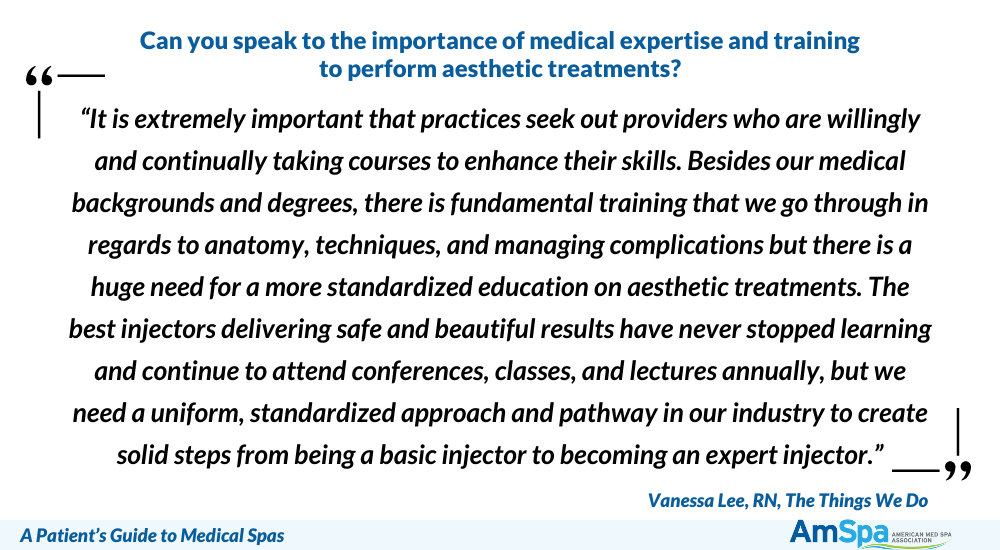
Patients can feel safe in a med spa knowing that these facilities are regulated just like a doctor’s office. The same state laws and medical boards and nursing boards that protect you at a doctor’s office also protect you as a med spa patient.
Patients know they can trust their med spa practitioners because those providers have the same board oversight as a typical doctor’s office. As state-licensed health care professionals, they have to follow the rules of their board and state regulations, beginning with the education and training it takes to qualify for those licenses.
Not only have your med spa nurses, physician assistants and doctors all met the requirements to attain their licenses, but they also continue to meet certain requirements to stay in good standing with their licensing boards. State requirements to maintain these licenses vary, but these boards have the public’s best interest in mind: these institutions want to credential providers who practice safely and responsibly and, by doing so, reflect well on the profession.
Another protection from these regulatory agencies is the ability for patients to confirm whether a person has the license they claim. The state boards are transparent with the status of a provider’s license and any disciplinary actions the board takes against them. You can search your state’s medical and nursing board provider lookups to learn more about the credentials of your aesthetic providers.
Med spa practitioners make ethical decisions in their care and treatment of patients. Your injector is held to ethical practices and codes of professional conduct, just like all other licensed health care professionals.
In everyday practice, aesthetic practitioners use their best professional judgment when caring for patients. Responsible care in a med spa might look like the following, as a start:
Acting in your best interest as a patient is not just an obligation, it’s a responsibility enforced by the provider’s licensing board. If a board finds unethical or unprofessional conduct, it can take action to protect the public by suspending or revoking that license, refusing to issue or renew a license, or by taking other disciplinary or non-disciplinary action.
Meredith Harris: “Our team receives ongoing training in complication prevention and management. Resources are prioritized in the purchase of items such as hyaluronidase, epinephrine, and AED's so that we can execute an action plan if/when the need arises. We also prioritize proper training in the use of all of our devices and injectable therapies. Finally, we invest heavily in the extended warranties for each device, which includes regular inspections and maintenance to keep devices safe for our patients.”
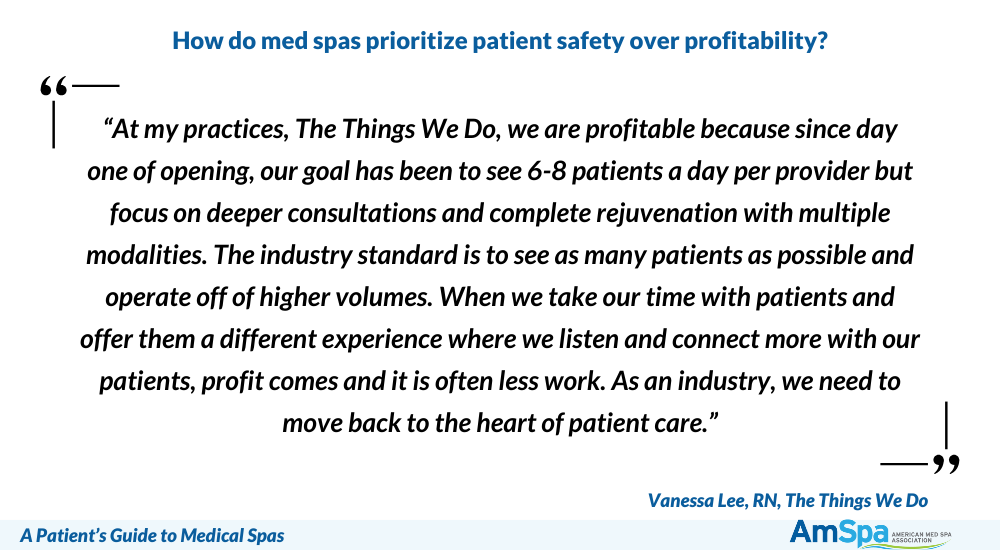
Med spa services that are considered medical treatments will require professional medical supervision. This supervision comes from a physician or, in states that have independent practice laws, from an APRN or NP who complies with all state statutes and regulations related to independent practice.
When you visit a med spa, the doctor, NP or PA who performs your consultation may decide that you are a good candidate to receive injections of dermal filler in your lips. They will document their diagnosis and the treatment protocol they recommend, including the product to use, recommended technique, the amount of product, etc. Your filler, neuromodulator or laser treatments do not have to be performed personally by this supervising practitioner—they can delegate to others who have the training and scope of practice to perform those treatments. A registered nurse in the med spa can take the order from the consulting practitioner and perform treatment as directed, provided they have the training and scope of practice to do so. Note that scope of practice varies from state to state, so check your state’s laws for more details on which providers can perform specific treatments.
That delegated provider is not practicing solo. The supervising physician or prescribing provider has given explicit instructions, and therefore the delegated provider is not making independent treatment decisions. At the end of the day, the supervising practitioners ensure that all treatments are being performed according to the practice’s standard procedures and make themselves readily available for consult in the event of an emergency.
Does your med spa need to have on-site supervision? States differ in their regulations here. Some go into specific detail for the distance or travel time that a medical director needs to be away from the practice when medical procedures are performed. Others specify that a physician must be onsite at all times if the only other employee besides the physician is non-medical. Accessibility is key in the event of an emergency, so these supervisors are reachable by phone or encrypted video call at a moment’s notice if they are not required to be on-site.
Once you have had a face-to-face consultation with a doctor, APRN or PA before your treatment, a doctor does not necessarily have to be on site.
One of the terms that you probably haven’t come across in other doctor’s offices is the term “medical director.” Med spa medical directors are licensed physicians (MD/DO) or can also be nurse practitioners or physician assistants in the states that have granted them independent practice. Because med spas are medical practices, they must be led and overseen by a supervising provider.
Medical directors take on the ultimate responsibility for all medical procedures performed at the med spa, meaning they are the one who is going to be held responsible if something goes wrong. With that responsibility, medical directors develop standardized protocols for every medical procedure, oversee treatment plans, and make sure the med spa complies with patient privacy and other health care regulations. They determine whether a provider has adequate training to perform treatments, and are in charge of both delegation and supervision.
These supervising medical directors undergo dedicated training in aesthetic medicine and gain experience to be able to perform every aesthetic medical treatment offered in the med spa. Most states require a medical director to have experience and training in aesthetic medicine so they can properly supervise these aesthetic treatments. How else would they know how to design treatment protocols and handle adverse reactions?
ByrdAdatto: “A ‘medical director’ at a med spa is typically a licensed physician with specific training and experience in medical aesthetics or related fields like dermatology or plastic surgery. Requirements vary by state, but the medical director must be able to oversee treatments, ensure regulatory compliance, and often act as a supervising physician for non-physician providers performing procedures. In some states, nurse practitioners or physician assistants may act as ‘medical director’ under certain conditions. The director is ultimately responsible for patient safety and the integrity of medical procedures carried out in the facility. Be mindful in some states, the use of the term medical director is a red flag, as it telegraphs that the practice might be non-compliant with other rules and regulations, like the corporate practice of medicine. It’s important to consult legal experts if having a medical director is compliant in your state.”
Examining patients and diagnosing treatment are the practice of medicine, which is why your consultations at a med spa are performed by a physician, a nurse practitioner or physician assistant. If a provider is not licensed to prescribe treatment, they are not the ones making decisions about your cosmetic procedures.
A compliant med spa will schedule you a consultation before your initial treatment, where you will meet face-to-face with a prescribing practitioner. They can then determine whether you are good candidate for a med spa procedure, make a diagnosis and build a treatment plan. After the in-person exam, the prescriber can delegate treatment to another provider who has proper training, experience, scope of practice and supervision.
Crucially, the consultation establishes a practitioner-patient relationship. A valid practitioner-patient relationship is important to providing quality health care services and meeting the standard of care. Requiring an initial consultation with one of these practitioners is a hint for patients that the med spa is practicing safe aesthetic medicine.
In med spa law, these consultations can be referred to as good faith exams, initial exams, initial consults, patient assessments, and sometimes physical exams. However your state names them, these consultations are a foundational step in a med spa patient visit.
The supervising physician can delegate good faith exams to nurse practitioners and physician assistants, who assess the patient and ask questions to understand their medical history. They will often ask lifestyle questions, ask about any recent medical incidents and ongoing medication that might be relevant to a cosmetic treatment. You will likely be asked to fill out a medical history form, and the practitioner will go over this with you.
Then the examiner will assess the patient’s physical condition in the areas where they will receive treatment. You might be asked to make different facial expressions, for example, if they are assessing your muscle movement before treatment with botulinum toxin. They will take photos of your current condition to allow for comparison after treatment.
The practitioner performing your consultation will ask about your concerns, aesthetic goals, and expected outcomes. They will describe the available treatment options and explain any potential complications and recovery time. They will walk you through any pre- and post-care for that treatment and send you home with printed instructions.
Your consultation is also the time to ask questions. This is a conversation, so ask them any questions you have about the treatment or the techniques they will be using. Ask them why you are a candidate for some treatments and not for others. Ask them about their background, training and continuing education.
When should you get a consultation? Before you receive your first treatment at a med spa, you should be given a consultation. If you are going in for a series of treatments and you have no changes in your medical history between sessions, you may not need a full consultation at every visit. Many procedures at a med spa are spaced out in multiple sessions, such as with laser treatments. If you are interested in a new treatment that was not included in your treatment plan, you will need a new good faith exam so you can be assessed and given a diagnosis relevant to that treatment, with a corresponding treatment plan.
Forehead relaxing treatments wear off in three to six months, depending on the product used, and these are treatments that patients seek for years on end to maintain their results. Now, just as we need annual physicals to make sure everything is in order, regardless of whether we’ve had any medical events in the last year, med spa patients should expect the same diligence from their aesthetic providers. After all, our health changes over time and you wouldn’t want to go too long without being assessed, even for the same treatment. A rule of thumb is for your med spa to perform a consultation at least annually.
Meredith Harris: “Aesthetic medicine should be held to the same standards as any other specialty in medicine. It is our ethical and moral responsibility to perform a thorough medical history and evaluation and perform a full-face assessment (assessing further areas of the body if that is warranted), prior to ever treating a patient. Inspection of areas that have been previously treated, observing for anatomical variances or evidence of poor product placement. Saying no to patients is never difficult after discussing safety, facial balancing and the art of our craft. Typically, once they understand the 'why' behind my 'no,' they are very grateful.”
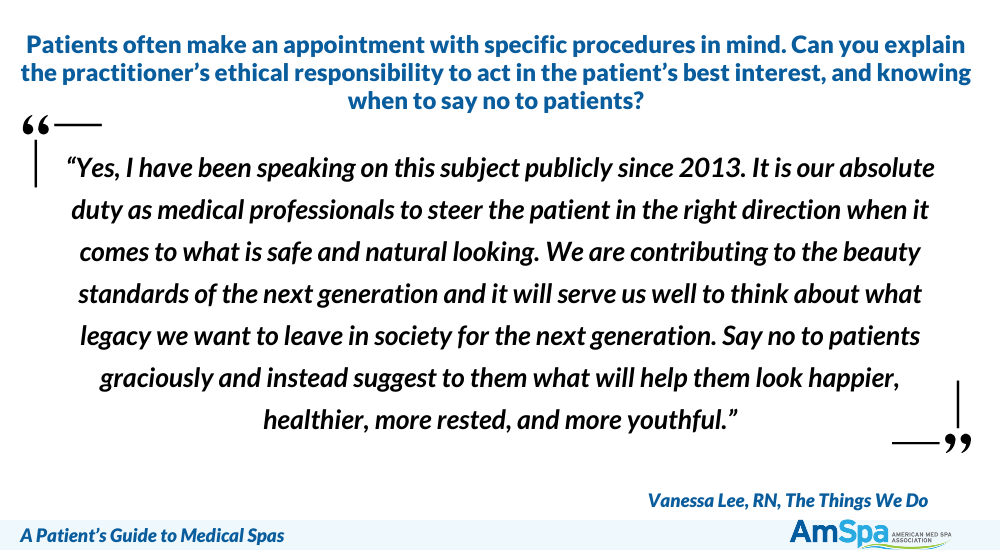
Just like in any other doctor’s office, you can expect to fill out and sign many forms related to the visit. These will include a personal health information privacy agreement, medical history form, informed consent form, and more. The purpose of these forms is to make you aware of your rights, discuss liability and make sure you are fully informed of the crucial medical details of the procedure, such as its risks and benefits.
When you sign an informed consent, this documents for the aesthetic practice that you are giving your “informed” consent to the treatment. The practitioner has fully educated you about the treatment, so you know what you are agreeing to allow them to perform.
These forms are not meant to trick you. They should spell out in great detail everything that you have just discussed with your practitioner during the consultation, including all associated risks, possible complications and chances of success. All possible risks, no matter how rare, should be explained by your practitioner and detailed in this form so there are no surprises if that event should occur. These forms are written in non-medical language, but if you still have any questions for the practitioner, ask them for clarification before filling out this form.
Meredith Harris: “Protocols should be maintained on-site and well understood by all parties involved in the delivery of services. These protocols should cover step-by step instructions on the set-up, delivery, and aftercare necessary for each treatment to be delivered safely. Additionally, protocols should include detailed instructions of what to do in the event of an adverse event. Our protocols are well organized and housed in two 3" binders on the shelf in our provider office. All supplies required in the event of an emergency are kept in one location and each provider and assistant in our office is familiar with their location and how to administer or assist when needed.”
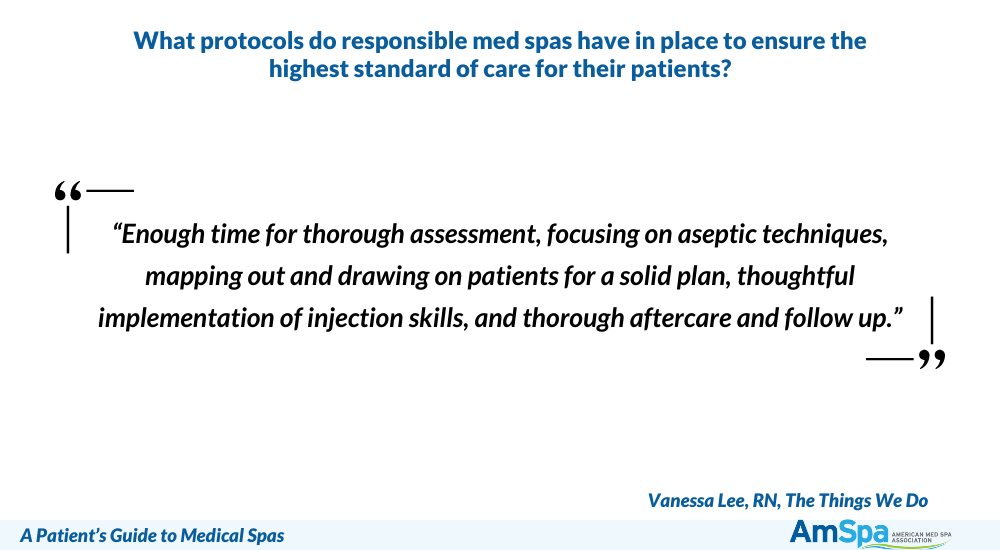
The supervising practitioner decides whether they can delegate an aesthetic medical treatment to another provider. How do they decide who can perform med spa treatments? It comes down to license, experience and training.
Training is not simply a checklist item for med spa professionals. Yes, their state medical and nursing boards require that they meet standards of conduct and renew their licenses as needed. Renewing a license usually means completing continuing medical or nursing education, which providers receive through trainings, conferences, seminars, online programs, virtual webinars and more. In such a fast-moving field as aesthetics, techniques and technology can quickly pass you by if you are not paying attention. Clinical education is a tool for your med spa practitioners to stay up to date with the latest best practices in the field.
As a patient, you wonder how long any one practitioner has trained in your desired procedure. Providers at all levels in a med spa receive training, from the medical directors to aestheticians and medical assistants. That training helps them build skills and strengthen their techniques to safely perform procedures. It also prepares them with the knowledge to prevent and manage adverse reactions.
Meredith Harris: “One of the most common and concerning misses, is the lack of preparation for the inevitable adverse event. If you do enough treatments in aesthetic medicine, you will have complications. It is how a provider handles them that matters most. Stocking the refrigerator with hyaluronidase is of the utmost importance. I recommend at least 20 vials, and check the expiration date regularly. A common second miss, is routine maintenance of energy based devices, which can lead to decreased efficacy and/or complications.”
Note for patients: hyaluronidase is an enzyme that breaks down hyaluronic acid, which is the key ingredient in many dermal fillers. This enzyme is used to dissolve unwanted filler and as an aid to resolve adverse events.
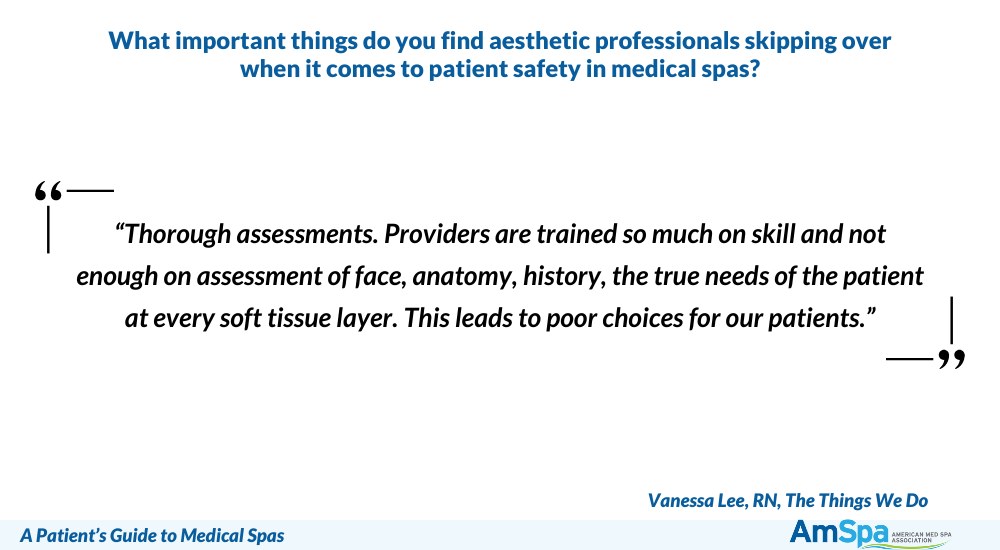
Medical aesthetic practices delegate the performance of medical treatments to licensed health care professionals under the supervision of a physician. In a med spa, those treatments can include laser resurfacing, tattoo and hair removal, body contouring, dermal filler, neuromodulators (Botox Cosmetic, Dysport, Xeomin, Jeuveau), microneedling, hormone replacement therapy, IV therapy and much more. Your favorite med spa employs a variety of licensed professionals who can safely perform these med spa treatments.
One of the most commonly asked questions is who can inject Botox or filler at a med spa. Regulations vary state to state, but typically your injector can be a physician, nurse practitioner, or physician assistant, or a registered nurse who is trained, qualified, experienced and properly supervised. Now, if your injector is an RN, you must be seen in-person first by a physician, NP or PA for the initial consultation. If it’s legal in your state, a trained RN has the necessary skills to perform your injectable treatment as directed by the supervising practitioner.
Laser treatments are slightly different in the med spa legislation; generally, individuals with sufficient training at the judgment of the medical director are able to perform laser hair removal. In the last legislative cycle, several states began introducing legislation that would specify training requirements to perform laser hair removal treatment. Check if your state has laser-specific requirements.
If you are wondering whether a treatment is within a provider’s scope of practice, you can look up your state’s regulations. You can verify a person’s credentials by asking for their license number or references, or by requesting to chat with the supervising physician.
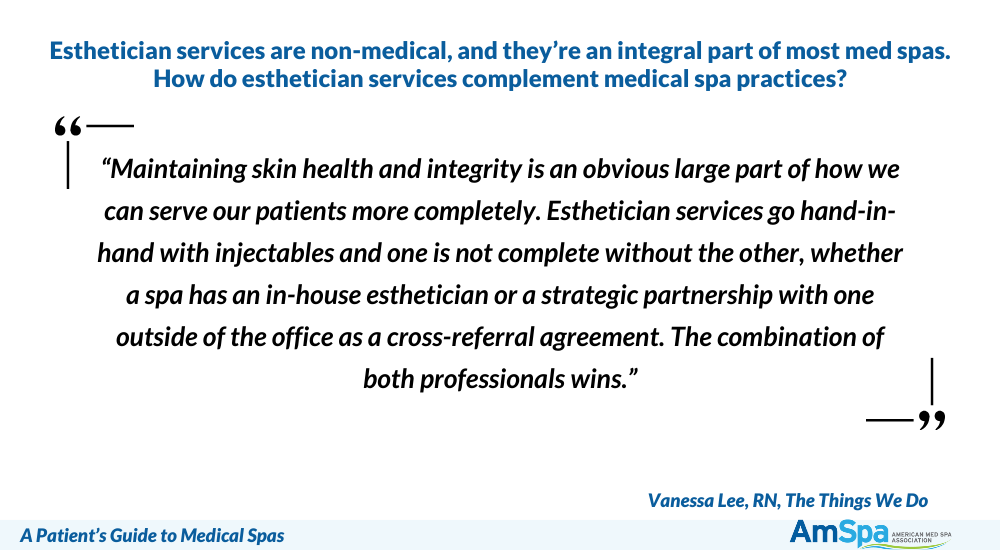
ByrdAdatto: “Med spas offer a range of non-invasive cosmetic treatments, combining medical expertise with aesthetic services. They’re typically run by licensed healthcare professionals like physicians, physician assistants, nurse practitioners, and registered nurses. These professionals should have received specialized training in medical treatments, such as botox, fillers, laser treatments, and skin care. It’s important to understand that treatments carry medical risks, making the qualifications and experience of the providers crucial for safety and results. Look for licensed medical and nursing providers that adhere to medical standards to ensure you're in good hands.”
Med spa law is present in state law, statutes, board rules and published opinions of the state medical or nursing boards. In the board rules, you can find definitions for licensing requirements, the practice of medicine, scope of practice for different licenses, supervision, delegation, ethical conduct and much more. If legislation that would impact that language is introduced, passed, and signed by the governor, the board will make updates to implement those changes.
Physicians and physician assistants are often both governed by the state medical board. Nurse practitioners, registered nurses, and licensed vocational nurses/licensed practical nurses are governed by the state nursing board. Licensed estheticians report to the cosmetology and barbering board. Medical assistants are classified as unlicensed individuals in most states, and are not licensed under a state board.
Once a med spa has its ownership structure and has established the proper business entity, it may have to register with the state medical board. On top of the state’s business registration requirements, med spa owners in several states have to meet additional requirements to register their medical entity, business name or med spa with the medical board. Typically, states do not require a med spa facility license on top of their other business certificates; the med spa’s ability to offer medical services comes from the licenses of its health care practitioners.
The cosmetology board can also get involved in med spa licensing. Med spas that employ cosmetologists and aestheticians to offer aesthetician services also fall under spa and salon regulations. Some states require those facilities to be inspected and licensed as a salon. The business may also need to apply for a cosmetology “establishment license” to register with the board of cosmetology and declare that aesthetic services are being performed.
IV therapy treatments to treat the symptoms of hangovers, and help with migraines, fatigue, dehydration, etc., have quickly expanded into med spas across the country. They are an easy add-on for patients waiting for numbing before injections. When a med spa adds IV treatments to its service menu, it then adds another state board: the board of pharmacy. Pharmacy boards regulate the prescription, dispensing, and compounding of medication by licensed prescribers and pharmacists.
Bioidentical hormones are another specialized treatment that comes with an added layer of regulation. The Drug Enforcement Administration (DEA) regulates controlled substances, such as anesthetics and hormones. Prescribers need to register with and obtain a DEA prescriber number in order to prescribe controlled substances, in addition to complying with their state requirements.
Med spas also have to comply with workplace safety standards specific to health care facilities. The Occupational Safety and Health Administration (OSHA) sets standards for workplace safety and enforces them with inspections. The most relevant standards for medical facilities are those that handle personal protective equipment (PPE) and toxic and hazardous substances.
Not only is it written in your med spa’s safety protocols, but it is also required for your med spa practitioners to protect both you and themselves by wearing the proper safety gear, such as medical gloves, respiratory protection, eye and face protection as necessary. Staff are trained to know when PPE is needed and what PPE a situation calls for.
Your med spa takes great care to perform medical procedures with the highest regard to safety for patients and practitioners. That extends from practitioner training to patient education, proper medication storage and sanitary preparation, a clean work environment, standardized treatment protocols, maintained equipment and emergency kits. Standards for health care facility regulation are state dependent, but this mindset and dedication to patient safety are common nationwide.
The medicines you pick up from any pharmacy in the U.S. have all been approved by the U.S. Food and Drug Administration (FDA). The administration, which is part of the Department of Health and Human Services, is responsible for ensuring the safety, efficacy and security of human drugs. In that role, the FDA approves medications to be used for certain indications. For example, Botulinum Toxin Type A received its first FDA cosmetic indication in 2002 to temporarily improve the look of moderate to severe glabellar lines, also called the “11 lines” between the eyebrows.
When you receive a dermal filler injection at a med spa, the product used is FDA-approved, purchased from the manufacturer in the U.S., and properly stored according to the manufacturer’s guidelines. Med spas can only legally purchase drugs and equipment that have been approved by the FDA, which includes lasers and other energy devices. The FDA approves all the packaging and inserts in these products, which are submitted by the manufacturer and approved as part of the prescription labeling. All packages meet requirements set by the FDA, which help you as a patient spot when something might not look right.
Keep in mind that a prescribing provider with a great deal of training and experience in aesthetics may choose to use approved medications in treatment areas beyond those approved indications, which would be called an off-label treatment. Your practitioner will let you know that the treatment they are performing is off label during the consultation, and this will be documented in your informed consent.
The FDA also looks out for patients by occasionally publishing consumer guidance, recommendations and warnings. The FDA is also the reason why med spas and other medical practices are able to prescribe compounded semaglutide and tirzepatide; the FDA maintains a Drug Shortage List. Listen to our conversation with ByrdAdatto’s Sam Pondrom, JD, on Medical Spa Insider to learn more about the FDA’s influence on medication availability and how long you can expect to receive compounded medical weight loss.
The most prominent patient privacy law is the Health Insurance Portability and Accountability Act (HIPAA). All the software and electronic medical record platforms that med spas use to manage patient records are HIPAA compliant. Any texts, emails and patient portal messages have to be carefully transmitted through secure channels. There are also state-level patient privacy laws. Med spas take great care to make sure your personal health information is safe and encrypted.
Unless you specifically consent, you don’t have to worry about your before-and-after photos showing up on the practice’s social media page either. Thanks to these personal health information laws, you have to give your consent before a medical practice can acknowledge you as a patient in that way.
ByrdAdatto: “New med spa professionals can try to familiarize themselves with regulations by researching state-specific medical and aesthetic laws, as these vary across regions. Unfortunately, these laws can be in several different regulations and opinions in each state (state statutes, medical or nursing board rules, and attorney general opinions). Joining professional associations, like the American Med Spa Association (AmSpa), can provide access to resources and legal guidance. It’s important to consult legal experts for setting up compliant practice structures as every state is different. Furthermore, anyone treating patients must undergo proper training and certification in each procedure offered to ensure that the patient is receiving medical services consistent with the standard of care. Keeping up with ongoing education and industry updates helps you stay compliant with evolving regulations. Proper malpractice insurance is also critical to protect the providers and your practice.”
As medical practices, med spas are subject to medical advertising rules and other professional conduct restrictions that impact how you can interact with them as a patient. Don’t feel pressured to tip your aesthetic provider or provide an exaggerated testimonial—these are potentially detrimental to the practice! You can better support your favorite med spa by telling your friends about how satisfied you are with their services.
Many of your med spa professionals are non-physicians: registered nurses, physician assistants, nurse practitioners, to name a few. If any of these providers were to accept or solicit tips, they could be seen as holding themselves out as practicing medicine and accepting compensation for medical services.
Similarly, a practitioner’s codes of ethical practice and professional conduct may conflict if tipping is viewed as outside of their best professional judgment. Because tipping is not typical in health care settings, accepting tips could be seen as an overcharge or inappropriate fee.
Day spas can offer reduced prices on services when a patient refers a friend. A med spa that attempts to do the same is potentially in conflict with medical kickback, fee-splitting or patient solicitation statutes. Restricting monetary incentives is just one way that the state’s rules help to prevent unethical practices and ensure the practitioners use independent professional judgment in their treatment decisions.
Word of mouth advertising is a powerful force in medical aesthetics, and it is comforting to know that patients who promote a med spa are doing as a sign of genuine support and customer satisfaction.
Med spas follow strict medical advertising laws. State licensing boards prohibit medical aesthetic practices from making any claims that are false, deceptive or misleading.
What can’t a med spa claim? They avoid hyperbolic claims of having the “best” providers, “expert” injectors. They can’t guarantee that a procedure will be painless or that a patient will leave feeling 10 years younger. If a med spa cannot prove a statement is true, the misleading language may catch the attention of a licensing board or a jaded competitor.
Another consideration for med spas is promotion from third parties. If a medical practice hires someone to promote or represent the brand, the language that they use reflects back on the business. They also cannot say anything misleading or exaggerated.
The same applies with testimonials on a med spa’s website and in advertising. A med spa cannot use testimonials proclaiming it as the “best practice in the city.” All testimonials have to be factually correct and based on the customer’s experience with the practice.
What does “medical aesthetician” mean? The reality is, the person’s credential is licensed esthetician, often seen as the suffix LE. The problem with a med spa provider calling themselves a medical aesthetician is that an esthetician’s license does not permit them to perform medical treatments, and this misleading title could give the false impression that they are licensed to do so.
As previously noted, a few states allow licensed aestheticians to step into the role of medical assistant when adequately trained, delegated to and supervised by a licensed prescriber who assumes responsibility. In that instance, they present themselves as medical assistants to avoid any confusion with their scope of practice as aestheticians.
Some states, like Oregon, recognize advanced aesthetician licenses, so someone can sport a “certified advanced esthetician” credential in that state. Master aesthetician is another common title, and also has no issue with mislabeling.
The other common trouble-making title is “certified laser technician.” While laser hair removal has come up in recent legislation, very few states certify laser technicians. The trouble with claiming to be a certified laser technician is that it’s unclear which entity provided that certification. Manufacturers of energy devices provide training to acquaint a med spa’s providers with the new technology, and that might be the source of the certification. An unlicensed person who gets certified by a private company, without the state’s recognition, may be misrepresenting themselves if they claim to be certified to perform laser services in their state.
As a patient, you will want to ask the laser technician about their certification and training. Be especially vigilant if you have darker skin, as a practitioner’s level of training can keep you safe and help to avoid complications such as keloids, pigmentation changes and scarring.
Beneath the glamour of med spas and aesthetic practices is a robust foundation in medical care. State and federal agencies regulate med spas as medical practices, create licensing and training requirements for practitioners, and put supervision and “who-can-do-what" rules in place to keep patients safe. As in any fast-growing space, there are more and less responsible practices. But the majority of medical spas are safe, are staffed by licensed health care professionals and implement all the patient protections you have in any other area of medicine.
Related Tags
Medical spa news, blogs and updates sent directly to your inbox.

Clinical
By Eric Atienza, Assistant Director of Digital Marketing and Marketing Technology, and Madilyn Moeller, Marketing Content CoordinatorWith the growing popularity ...

Consumers
By Madilyn Moeller, Marketing Content CoordinatorWalk into any modern med spa, and you're likely to find PAs taking a prominent ...
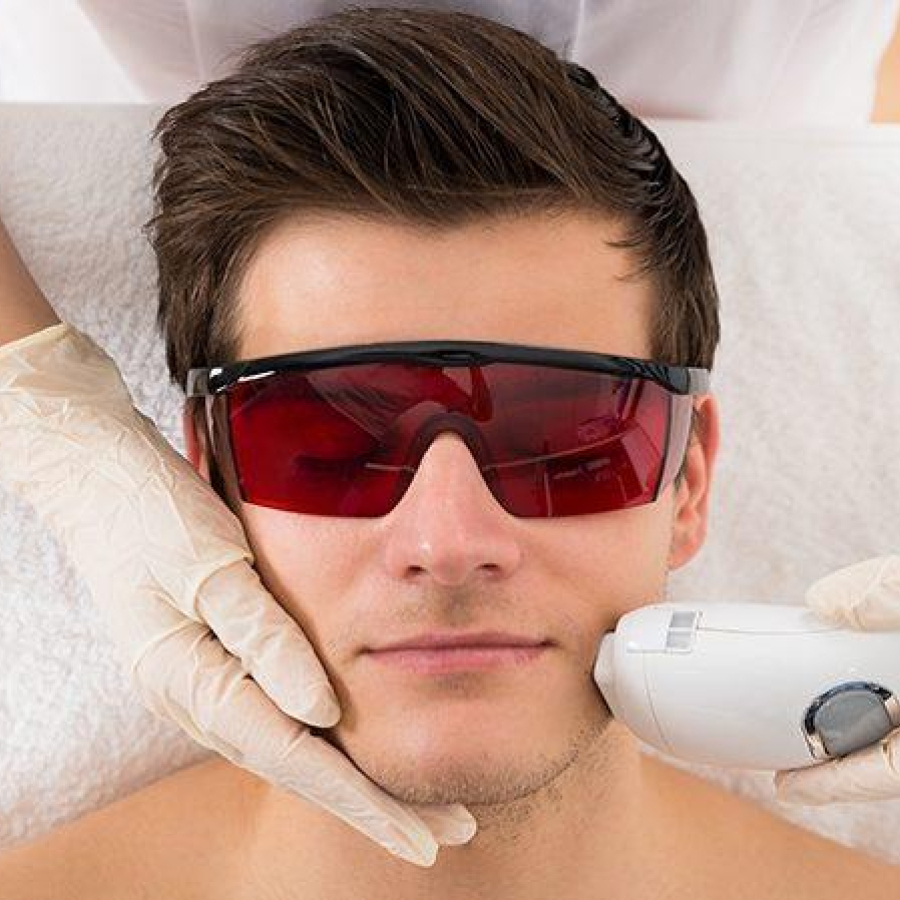
Clinical
With Taylor Siemens, NP-CTo set the foundation for glowing aesthetic results, medical spas often incorporate laser skin resurfacing treatments into ...
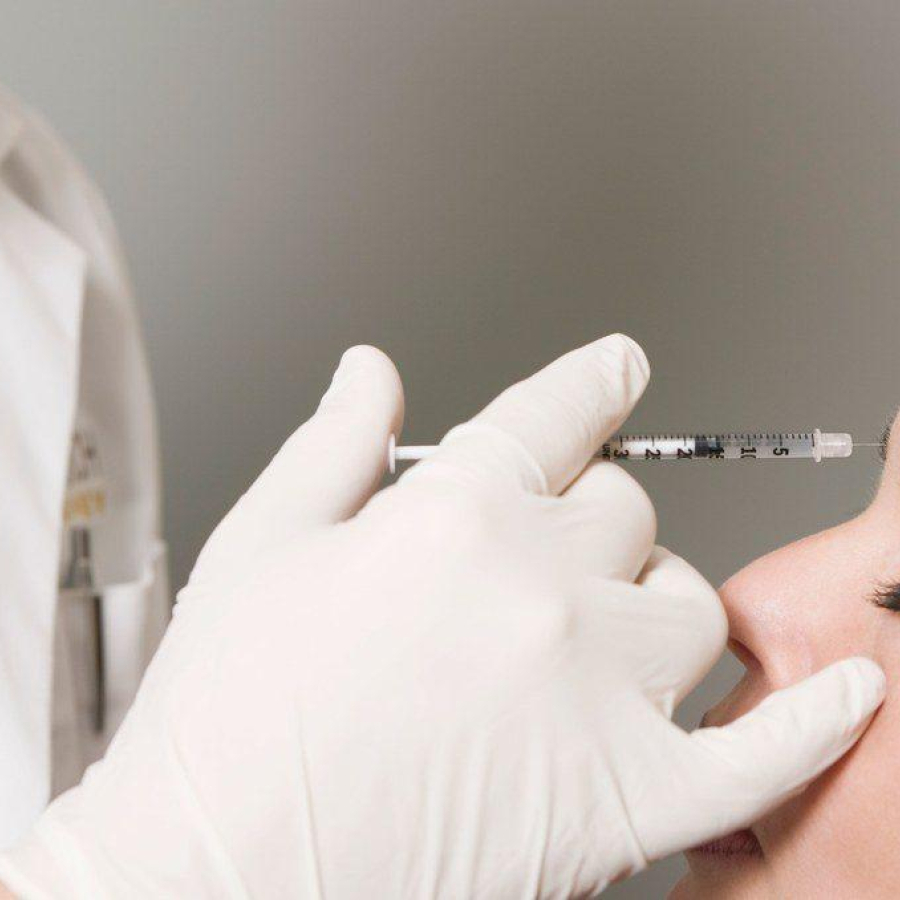
Clinical
With Alexa Nicholls Costa, NP, and Alexandra Rogers, NP, LexRxBotulinum toxin and dermal filler treatments are often referred to as ...